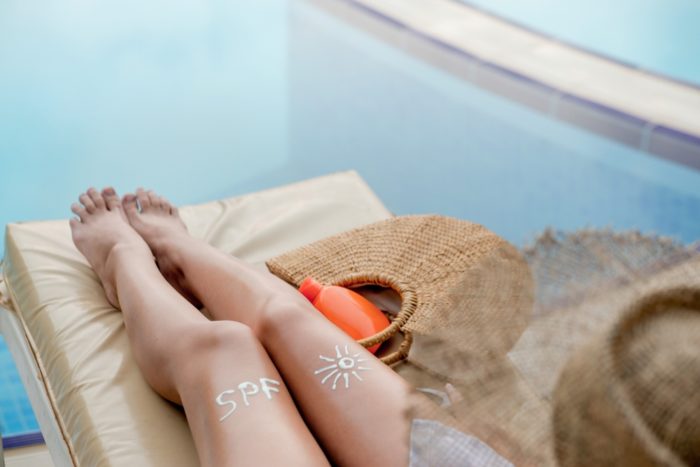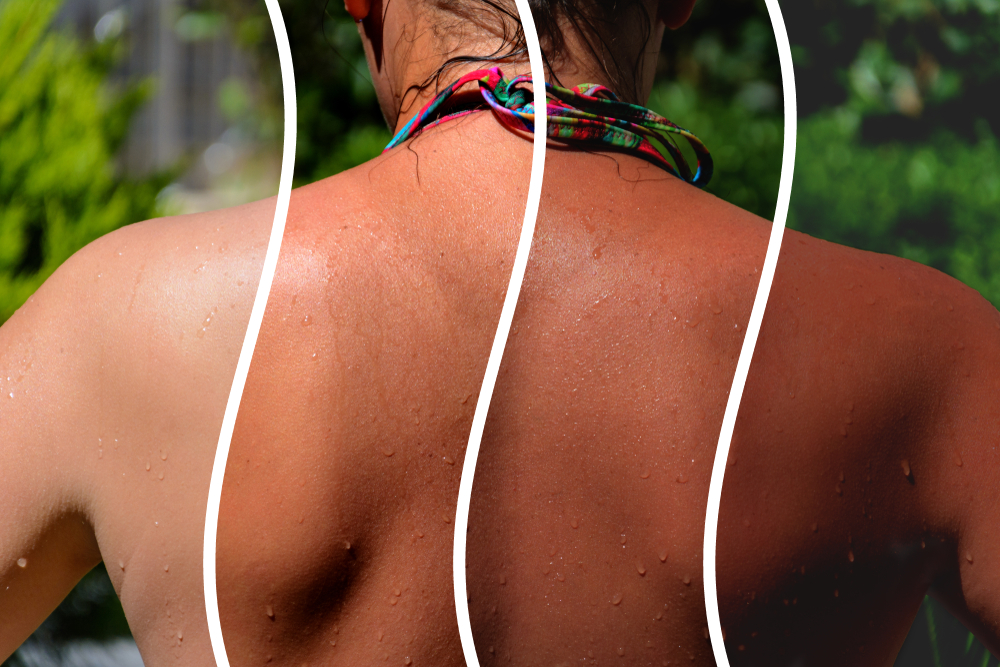
Skin cancer – your legs are no exception to the rule
May 6th, 2022It’s that time of year when most people reveal their pale, pasty winter legs to the world but it’s important for them to remember that their legs are no exception to the rule when it comes to skin cancer and the sun’s harmful ultraviolet rays.
Many people risk the possibility of developing skin cancer for the sake of vanity, is it worth it?
This summer, holidaymakers will flock to warmer climates hoping to develop a glowing, golden tan. On hot summer days, during the midday sun, wise people go into the shade to reduce their exposure. A lot of people understand the risk of sun tanning and skin cancer so they limit the time their face and upper body bake in the glorious sunshine but are tempted to leave their lower limbs exposed. Is that you?
If you’ve over worshipped the sun and experienced sizzling sunburnt thighs, knees, ankles and feet you most probably have also suffered from prickly heat and tight, sore, peeling skin which isn’t pleasant. It has most probably left you hiding indoors taking cool showers and applying aftersun products that don’t appear to do a lot most of the time. Not only are you causing yourself a lot of discomfort, but you are also putting yourself at high risk of developing skin cancer for the sake of vanity.
Skin cancer, treatment and know your skin…
Skin cancer is the growth and mutation of abnormal cells in the epidermis – the outermost skin layer. The 2 main causes are overexposure to UV (ultraviolet) rays from the sun and the use of tanning beds.
The most common skin cancer is Melanoma which forms mainly on the face or trunk of affected men and in women it often develops in the lower legs. There are many characteristics – a large brownish spot with darker freckles, moles that change in colour, size, texture or that bleeds. A painful lesion that itches or burns. Small lesions with an irregular border and portions that appear red, pink, white, blue or blue/black. There can also be dark lesions on the palms, soles of the feet, fingertips or toes.
Two other well-known skin cancers are Basal cell carcinoma which forms in sun-exposed areas of the body, such as the neck or face. There are 3 different characteristics – a pearly or waxy bump, flat flesh-coloured or brown scar-like lesion or bleeding or scabbing that returns. Another is Squamous cell carcinoma which forms in sun-exposed areas of the body such as the face, ears and hands and is more prevalent in people with dark skin. There are 2 different characteristics – firm red nodules or flat lesions with a scaly crusted surface.
Less common forms include Kaposi sarcoma, Merkel cell carcinoma and Sebaceous gland carcinoma.
There are standard types of treatment for skin cancer including:
- Simple excision where the tumour and some of the normal tissue around it, is cut from the skin.
- Mohs micrographic surgery where the tumour is cut from the skin in thin layers, and those layers continue to be removed until no more cancer cells are seen.
- Shave excision where the abnormal area is shaved off the surface of the skin with a small blade.
- Cryosurgery where a treatment that uses an instrument to freeze and destroy abnormal tissue, such as carcinoma in situ.
The month of May is Melanoma awareness month a good reminder of the deadly disease. 86% of cases of melanoma are preventable but increasing numbers of people are being diagnosed with melanoma skin cancer. There are now more than 16,000 new cases each year in the UK. Melanoma Focus is a national charity dedicated to providing help and support to Melanoma patients and professionals as well as raising awareness of melanoma, the 5th most common cancer in the UK. The charity’s goal is to encourage everyone to be sun-safe and encourages anyone who has noticed changes in their skin to contact their GP. Many moles or lesions do not end up being anything serious but early diagnosis is important. Susanna Daniels, CEO of Melanoma Focus understands the benefits of exposing ourselves to the sun and she explains, “We’re not telling people they shouldn’t enjoy their summer but, if you’re going to be exposed to the sun, then it’s crucial that you protect your skin from a young age.”
You can minimize the risk of skin cancer by taking some simple steps.
- Avoid the midday sun – the sun’s rays are strongest between 10 am and 4 pm. It’s worth noting that you absorb UV radiation all year round, clouds offer little protection – even in the winter months. Avoiding the midday sun reduces the risk of sunburn or suntans that cause skin damage and increases the risk of developing skin cancer.
- Wear suntan lotion all year round but be aware, that sunscreens don’t filter out all harmful rays, especially the radiation that can lead to melanoma. Use at least an SPF 30 even on cloudy days. Apply generously and repeat every two hours or more often if you are swimming or sweating. Include protection for your lips, tips of the ears, feet and backs of the hands and necks.
- Wear protective clothing, cover your skin with dark, tightly woven clothing and a broad-brimmed hat or baseball cap. Don’t forget those all-important sunglasses. Did you know you can get sunburn on your retina in the eye? Make sure you choose sunglasses that block UV radiation – UVA and UVB rays.
- Avoid tanning beds – the lights used in tanning beds emit UV rays and can increase your risk of skin cancer.
- Sun-sensitizing medications – some over the counter or prescription drugs, including antibiotics, can make your skin more sensitive to sunlight. Ask your doctor or pharmacist about whatever you are taking and your reaction to the sun.
- Check your skin regularly and report changes to your doctor. Examine your skin often for new skin growths or changes in existing moles, freckles, bumps and birthmarks. Look over the whole body, not just the obvious places.
Use this ‘Know your skin’ guide from Melanoma Focus which will help you check your skin and nails for skin cancer. In the guide, they recommend you do the check once a month and explain how you can self check by using a mirror or taking photos or having a skin buddy! They supply a template for you to record dimensions of any areas of concern.
Curaderm (BEC5®) – The world’s first anti-Cancer skin cream
BEC5® cream, also known as Curaderm, is an effective, convenient and non-invasive treatment for non-melanoma skin cancer.
Curaderm (BEC5®) cream is particularly potent when used to treat basal-cell carcinomas (BCC) and squamous cell carcinomas (SCC), although it is also effective on benign tumours such as sun spots, age spots, Keratoses and Keratocanthmoas.
Find out more: https://www.antiaging-systems.com/products/curaderm-bec5/
There are safe options to achieve lovely tanned looking legs. Tanning formulas have dramatically changed over the last few years. They are sold in the form of foams, creams, serums, mists or gels.
- Tanning products – investing in some self-tanning products can give you a natural tanned or darker pair of legs. Sunless tanning products are a convenient shortcut to tanning without risk.
- Spray tanning – often referred to as fake tanning or UV-tilled tanning is another artificial way of getting a golden glow on your lower limbs. A technician uses an airbrush to spray the entire body. The biologically active compound in the spray is DHA (Dihydroxyacetone) and it is obtained from plant sources. It works with amino acids in the skin causing a chemical reaction.
- Tanning towels – contain a neat, self-tanning formula which functions in conjunction with the proteins and amino acids in the skin to produce a healthy glow. The towels last for a couple of days so you can reapply them to darken the tan.
It’s important to consider your skin type when choosing tanning products, it’s not a matter of one brand suits all. For pale skin opt for a red-based product with DHA levels of 2-5%. For olive skin opt for green base products and for black skin opt for a product with DHA levels of 18%. You should use different products for your body and face. Your face is more sensitive and fake tan products contain humectant and anti-ageing ingredients such as hyaluronic acid.
Check out the best fake tan products 2022 from Marie-Claire magazine.
https://www.marieclaire.co.uk/beauty/make-up/best-fake-tan-211981
An interesting product worth a mention is MSH-2 (MSH2Pro). Just one or two sprays daily of MSH2Pro helps to produce a tan without the need to expose the skin to direct sunlight. MSH2Pro works synergistically with other hormones to rejuvenate cells and organs.






